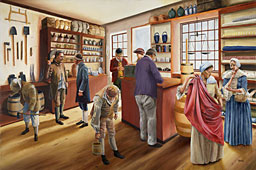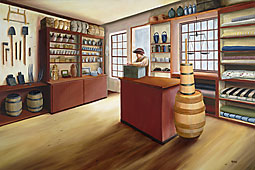For Teachers: Lessons
Lesson 3: Boom & Bust: Post-War America
Learning Objectives
After completing this lesson, students will be able to:
- Explain why the American Revolution was followed by economic boom times and describe what boom times looked like
- Describe the causes of the faltering economy, or “bust,” that quickly followed the boom times at the end of the war
- Compare and contrast the life experience of some of the people in this scene just after the war, and a year later
- Describe the chain of debt that involved farmers and merchants in western Massachusetts and Boston merchants
- Explain the reasons for, and nature of, the taxes imposed by the Massachusetts government
- Examine and analyze primary source materials
Skills
- Interpreting visual information
- Observing and describing
- Thinking critically
- Expressing opinions
- Analyzing visually
- Understanding historical perspective
- Gathering and using information
- Interpreting information
Introduction
In this lesson, students learn how pent-up demand, coupled with post-war optimism, fueled a sharp, dramatic initial upswing in business once peace was declared. The initial “boom” was followed by a “bust,” as the faltering post-war economy, mounting debit and trade patterns led to desperate times for ordinary citizens. The scene is set in John Williams store in Deerfield, Massachusetts in November 1783, and the fall of 1784.
 |
 |
Boom, Bust © 2008 Bryant White |
|
Guiding Concepts
Pent-up demand, coupled with post-war optimism, fueled a sharp, initial upswing in retail activity in stores. People bought and sold using cash and goods assigned a market value, such as wheat and other agricultural products, labor, and even ginseng. Shopkeepers, like John Williams of Deerfield, were part of a complicated economic web that extended far beyond the local customers and the town of Deerfield. The government of Massachusetts, struggling to pay down its large war debt, enacted an ambitious plan to pay it off through a program of systematic and regressive taxation—taxes that were to be paid in hard money—gold or silver. A severe recession caught people off-guard and dashed their hopes for prosperity.
Preparing to Teach
- Familiarize yourself with the Boom & Bust historic scene, linked to from the Historic Scene menu [scenes/index.html]. Read the three tabs, then roll your cursor over the highlighted hot spots in the illustration. Follow the links in the rollovers. Below the illustration and the tab content, read the four OBSERVER comments, the four essays in the THEMES section (Note: Pay particular attention to the "Labyrinth of Debt" essay in the Getting By & Getting Ahead section of the THEMES AND ESSAYS section), and follow the links in the RELATED TO THIS SCENE section.
- Familiarize yourself with the Library of Congress’ Using Primary Resources.
- Although not explicitly referred to in the lesson, you can incorporate selections from the Timeline and Music section into the lesson.
Teaching the Lesson
- Class Assignment: Prior to the one or two class periods spent on this lesson, make the following website preparation assignment:
- Go to the Boom & Bust historic scene from the Historic Scene menu. Read the Overview tab, the Boom tab, and the Bust tab. Roll your cursor over the rollovers within the illustration and read the text. Note that the rollovers are different for each illustration; each tab has a different illustration and a different set of rollovers. Students can choose to follow the links for character narratives.
- Read the observer comments, the four essays in the themes section, and follow the links in the related to this scene section, studying the material displayed.
- Read the "Labybrinth of Debt" in the Getting By & Getting Ahead section of the Themes and Essays section),
- Assign each of the following characters to a student (or a small group of students) so the student(s) can assume that historic persona in class: Mary Harvey, Joseph Stebbins, David Hoyt, Jr, Justin Hitchcock, John Williams, Elihu Ashley. Students should read and study the narrative of their assigned persona. The character narratives are found in the People menu.
- Assign the following observers to a student (or a small group of students) so the student(s) can assume that historic persona in class: Charles Sigourney, Abigail Adams, Richard Price, Anonymous. Note that Abigail Adams has a character narrative in the People menu.
- Class Activity: Boom & Bust Role Play: Project the image of the Boom illustration. (Note: You can enlarge the illustration by clicking the Show Large Version icon in the bottom left corner underneath the illustration). Assemble the historic personas at the front of the class. The date is November, 1783. Ask each historic figure to describe what his/her life is like. Now project the image of the Bust illustration. The date is November, 1784. Ask each historic figure to describe what his/her life is like now. Lead the class in a discussion comparing and contrasting conditions in November of 1783 and the fall of 1784. Use the discussion questions below and write key points on a flipchart or blackboard.
- Class Activity: Primary Resource Study: Project the image of the letter from Charles Sigourney to John Williams (found in the related to this scene links) requesting payment for debt. Use the zoom function to look carefully at the letter in the original handwriting, then look at the transcription. Discuss the meaning of the letter in the larger context of the economy. Use other primary source materials as time allows, such as the Address to the People of Several Towns and the Athol Petition to the General Court in the related to this scene links..
- Class Activity: Chain of Debt Role Play: Divide the class into the following groups: farmers, trades people (e.g.,blacksmiths and hatmakers), western Massachusetts shopkeepers, Boston merchants, Massachusetts legislators,veterans of the Revolutionary War, government tax collectors, and speculators. Randomly pass out pennies and nickels (or some other type of symbol for hard specie) of varying value to everyone. Make sure farmers and trades people get little specie. Pass out pieces of paper to farmers and trades people indicating goods they have to sell, like agricultural products, livestock, hats, lumber grain, shoes, potash, ginsing, butter, cheese, etc. Give speculators Continental certificates (monopoly money?) that they have purchased from war veterans, hoping the Massachusetts government will pay them off at full value. Start the chain going when a Boston merchant, who can no longer sell goods to the British West Indies, demands payment in hard money from a shopkeeper, like John Williams, for merchandise purchased previously. At the same time, the tax collector comes forward and demands payment of much higher taxes in hard currency from farmers and shopkeepers to help pay the state debt (including those certificates that veterans sold to speculators). Orchestrate a role play among the various parties.
- For a similar exercise, go to Springfield Armory: Curriculum Materials and click "Simulation."
- Class Discussion Questions:
- Why was there an upswing in commerce right after the American Revolution? (goods difficult to get during the war, Americans both producers and consumers, Americans like British goods, Britain is eager to sell to Americans, hard money and optimism fuel pent-up demand)
- What is the nature and availability of goods illustrated in the Boom painting? (great variety and availability)
- During time of economic prosperity, like just after the War, how did people pay for goods they purchased in stores like that of John Williams’? (paid with goods like grains, dairy products, meat, potash, lumber — sold at values determined by local and regional markets; some cash; credit)
- Why does John Williams buy wild ginseng from Abel Cook? (hopes to make money selling it to China, via Boston merchants)
- What purchases is Joseph Stebbins making and why? (nails because building projects are booming)
- Did Americans, as a rule, make or import, most of their clothing prior to the war? (import, until a series of non-importation agreements were set in place to protest taxation without representation)
- Why were the West Indies important in trade with America? What happened to this trade as the end of the war? (sharp reduction of US trade options)
- What are the economic problems that caused the boom to go bust? (slow and faltering economy; changed trading patterns and trade imbalance; rising state debt and new taxes—to be paid in hard currency—aimed at paying off the war debt; people unable or unwilling to buy; hard currency—gold and silver—that accumulated during the war due to hoarding and fewer opportunities to spend, had been siphoned off abroad and out of the economy.) Does any of this sound familiar? Are there parallels to today’s economy?
Additional Resources
Books
- Gross, Robert, ed. In Debt to Shays: The Bicentennial of an Agrarian Rebellion, volume 65. Boston, MA: The Colonial Society of Massachusetts, 1993.
- Richards, Leonard. Shays’s Rebellion: The American Revolution’s Final Battle. Philadelphia: University of Pennsylvania Press, 2002.
- Starkey, Marion. A Little Rebellion. New York: Knopf, 1955.
- Satzmary, David. Shays’ Rebellion: The Making of an Agrarian Insurrection. Amherst, MA: University of Massachusetts Press, 1980.
Websites
- Library of Congress: Using Primary Resources
- Library of Congress: Digital Resources Related to the American Revolution
- Library of Congress: American Memory
- Shay’s Rebellion Song
- Best of History Websites: American Revolution and Independence
- PBS: Liberty: The American Revolution
- NEH Edsitement: History and Social Studies
- James Madison Center: US History Curricula
- History Institute, University of Massachusetts: Shays’ Rebellion and Related Resources
Movies
- The History Channel Series: 10 Days That Changed America: Shays’ Rebellion: America’s First Civil War; 60 minutes
- Calliope: A little Rebellion Now and Then: Prologue to the Constitution; 30 minutes